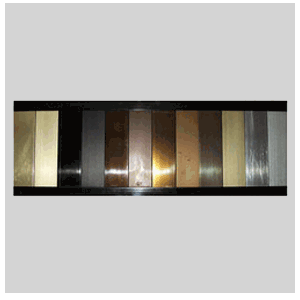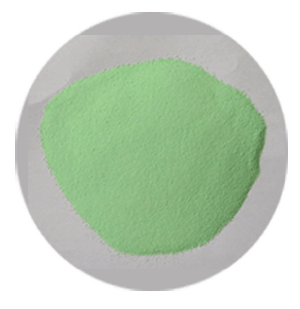
Alumon ED Color Process
Features of Alumon ED Color Process.
This process is adopted by various different fields like optical instruments, home-Appliance, parts for construction etc. For now, many applications are using organic dyes so mostly they have some light fastness problem, and also a little high cost problems. Below process will explain about Alumon ED color Salt process. Sn ion is not a pollutant metal, which has no problem as an additional process to the current process and high value added not discoloring black coloring can be achieved easily.
| Ingredients of Make-up solution | Density | Condition |
|---|---|---|
| Degreasing Sulfuric or Alkali Degreasing | As same as existing process | |
| Anodizing H2SO4 Al2(SO4)3 |
150~180g/ℓ 1~5g/ℓ |
Current: 1.0A/㎡ Voltage: 15~17V ․ DC Temperature: 20℃ Time : 30min |
| Black Electro-coloring Alumon ED Color Salt H2SO4 Sn Stabilizer |
15g - 20g/ℓ 15g - 20g/ℓ 10g/ℓ |
Current: 1.0A/㎡ Voltage: 15~17V - AC Temperature: 20℃ Time : @ 10~15min Conductivity : 65㎳/cn |
| Sealing | Hot or Cold Nickel salt Sealing |
Temp. : 90℃(hot),30℃(cold) Time : 10-20min |
Advantage
- Even black color can be achieved by Sn salt black electro-coloring
- Can get high light fastness anodizing film economically
- Anti-alkali property is increased by Ni salt sealing
- No need for waste water treatment for metallic salt
- Use AC Power.
Important Processes
- Use Al alloy as a conductive material, and firmly fix it.
Anode treatment on parts frame, as the black electro-coloring process shares facilities, there should not be any relaxation or movement of the point of electric contact. In addition, during the 2nd, 3rd electrolytic process, as there is no flow of electricity on the surface of the conductive material, non-conducting status on the anode surface can be happened by movement of the point of electric contact. - High-speed electrolytic can be also used for anode process conditions.
- Electrolytic solution adopts mechanical stirring.
Recently, for electrolytic solution stirring, people normally use mechanical stirring not air blowing.- Normally, in air blow, the air bubbles can be dispersed into the electrolyte and it can be attached onto the surface of the parts frames. As these bubbles have no conductivity, the efficiency of electrolyte decreased by 5% and more
- During the electrolysis, as the heat is occurred, it need to be cooled. The heat occurred by the parts frames’ electrolytic process is only @ 18%. Others are from joule heat coming from resist of electrolyte.
- Etc.
- When you finish the anode process, it is recommended to drop the voltage quickly. As the thickness of the film barrier is depend on the voltage, if you decrease the voltage slowly, the partial color difference can happen because of varied thickness of barrier of aluminum parts frame.
- Sulfuric acid anode process, 30% sulfuric acid, 2A/㎡ current density condition can give good film, and 2times high speed electrolytic process also can be used. However, rinsing in the pore should be done enough.
- As oxylic acid anode electrolytic process is relatively cost high for COD related expenses for waste water treatment process and it should be considered well. In addition, to get relatively thin barrier layer, you should control it by decreasing voltage when you finish the electrolytic coloring.
Maintenance.
- Maintenance of electro-coloring bath.
When Old Alumon ED Color salt bath had too much sediment and as it getting milky white color, it caused uneven coloring result, and also became a reason for cost increase by frequent new make-up of the bath. However, now these problems were also solved. - Important condition
Generated unsealed anode film should be carefully electrolytic processed by dipping into color electrolytic solution by carefully checking the movement of the point of pollution after rinsing.- First, do ageing by infiltrate the electrolyte into the pore. In this case, the parts should be stayed at least 2minutes, if the solution is not enough in the pore, electrolysis can be imperfect.
- Electrolysis should soft start and be conducted again. Gradually increase AC power. Sudden high currenct can interrupt the process of black electro-coloring
- Post treatment of Black
About 10min of electro-coloring, just check the result of black. If the color is not enough, do additional several minutes of electro-coloring process. Black color can varies from gray to deep black, but the degree of color should be checked by the operator with the naked eyes.
If the color is lighter than required standard color, it is recommended to do additional several minutes of electro-coloring, but if it became deep black at early stage, you can not go back to light black or gray color again. In addition, minute metal Sn can be extracted by over-electrolytic process, then it can be removed by dipping in to diluted nitric acid after sealing. (by dissolving) - Sn ion has no problem with waste water treatment regulation
Normally, for waste water which contains heavy metals are strictly regulated by law, so like Ni ion need to install special treatment facility of wasted water. However, there are no regulations for Sn ion, so you only need to follow COD and neutralization regulation rules.


.png)

.png)
